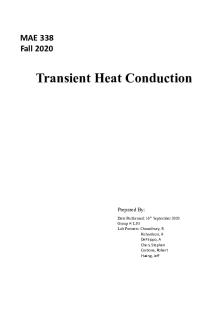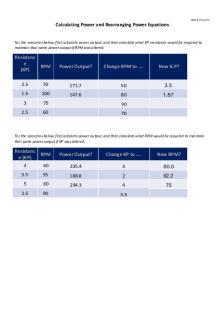Pinacol Rearrangement Full-lab report PDF

| Title | Pinacol Rearrangement Full-lab report |
|---|---|
| Author | Ahmad Rafay |
| Course | Organic Chemistry Ii |
| Institution | Virginia Commonwealth University |
| Pages | 5 |
| File Size | 152 KB |
| File Type | |
| Total Downloads | 96 |
| Total Views | 135 |
Summary
The complete lab report for a very difficult lab! Received a very high score of 94%!...
Description
Ahmad Rafay Section: L12 Drawer: E Date: 2/16/2019 Pinacol Rearrangement Lab performed on date(s): 2/5/19 - 2/12/19 Abstract: In order to interpret and understand the mechanism of pinacol rearrangement in a laboratory setting and also obtain a more practical knowledge of Raoult’s law, the rearrangement of pinacol yielded with an acid to obtain pinacolone was done. Several basic techniques were used in order to properly perform pinacol rearrangement, such as distillation. When the results formed, a percent yield of 108% was obtained (1.37 g), where the limiting reactant was pinacol, and which is explained from an experimental error where a proportion of the aqueous layer was combined with extracted pinacolone from the glassware. An alkane stretch was shown on the IR spectra as well as a ketone group. When pinacol is yielded with an acid (H2SO4), a pinacol rearrangement reaction occurs causing water as well as pinacolone to form. On the NMR spectra, orientations of the hydrogens in pinacolone where 9H and 3H were present at 1.23ppm and 2.23H respectively. As resulted, the product yielded after this experiment had little to no impurities. Synthetic Equation:
1
Table 1: Physical Properties used during Experiment of Pinacol Subjected to Rearrangement
Chemical Name
Physical Structure
Molar mass (g/mol)
Melting point (°C)
Boiling point (°C)
Density (g/cm^3)
Notable Hazards
Pinacol C6H14O2
118.174 g/mol
40-43°C
174°C
0.967
Flammable & eye irritant
Sulfuric acid H2SO4
98.079 g/mol
10°C
337°C
1.84
Irritant, corrosive
1 Sigma-Aldrich. Safety Data Sheet: R-(+)-Limonene. www.sigmaaldrich.com 2015. Retrieved
February 20, 2019.
Sodium chloride NaCl
58.44 g/mol
801°C
1.465°C
2.16
None
Sodium sulfate Na2SO4
142.04 g/mol
884°C
1,429°C
2.66
Eye irritant
Pinacolone C6H12O6
100.161
-52°C
103-106°C
0.7229
Eye irritant, flammable
2,4Dinitrophe nylhydrazin e C6H6N4O4
198.14 g/mol
198-202°C
-
-
Flammable & carcinogenic
2
Procedure After adding 1.5 g pinacol and 15 mL of deionized H2O to a 50 mL round-bottom flask, the mixture was heated gently in a heating mantle until dissolved. The flask and contents were cooled to room temperature by immersing it within a tap water bath to avoid recrystallization. After adding one boiling chip, the contents were swirled carefully 2.50 mL of concentrated sulfuric acid as well as a stir bar was added to the flask which caused it to become hot. Again, the flask was cooled within a tap water bath after the acid addition and swirled afterwards for 10 minutes. The flask was connected to a simple distillation apparatus and used as a distilling flask to distill the mixture into a 50 mL round-bottom flask. After this pinacol solution reached 100°C, distillation was stopped. 2.50 mL of saturated sodium chloride solution was added and mixed within the distillate. The formed aqueous layer was removed using a transfer pipet. It became difficult to identify the separate layers so a separatory funnel was use to better divide the two layers. The organic layer was dried over anhydrous sodium sulfate and the dried liquid was decanted into a pre-weighed sample vial. The liquid was then weighed, and the percent yield was calculated. A 2,4 DMP and an IR spectrum was run on the sample. A calibrated transfer pipet was used to transfer 1 mL of 2,4 DMP test reagent to a large test tube. Five drops of the product was added and results were recorded. The product was saved for next lab for the NMR spectrum. Calculations: Theoretical Yield: (1.50 grams of pinacol x 1 mole of pinacol x 1 mole of pinacolone x 100.161 g/mol pinacolone)/ (118.176 g/mol pinacol x 1 mole pinacol x 1 mole pinacolone) = 1.27 grams of pinacolone Percent Yield: Actual yield of Pinacolone: 1.37 grams 2 Data-table and information obtained from PubChem, Open Chemistry Database
Equation used: (Actual Yield/Theoretical Yield x 100) 1.37 grams pinacolone/1.27 grams of pinacolone = 108% Yield Results: In regards to observations and results, the distillation of pinacolone held a mass yield of 1.37 grams which is the actual yield, and the mass of the vial alone was 41.17 grams. The vial with the pinacolone had a precise mass of 42.54 grams. The theoretical yield of pinacol was 1.27 grams, which made it our limiting reagent. As for experimental components and weights, 1.50 grams of pinacol, and 2.50 mL of sulfuric acid were accurately obtained.Nine hydrogens were also depicted using the NMR spectra at 1.24ppm and nine hydrogens at 2.23ppm. Obtaining the IR spectra, several observations to discuss such as peaks displayed at 1706.70cm, 2873.61cm, and in the 2914.13-2934.38cm range. The 1706.70cm peak indicated a ketone structure present and several C-H stretches(alkane stretch) for the remaining peaks described. Discussion In order to obtain a synthesis of pinacolone, a distillation technique was performed in which pinacol was yielded with water, sulfuric acid, and heat. The amount of pinacolone being used was halved. All following proportions while carrying out the experiment were also halved. A percent yield of 108% was obtained and due to this overly high amount calculated, a definite experimental error had taken place. In the reasoning of than the ideal percent yield obtained, the aqueous layer was more than likely combined with the extracted product after the organic product had been extracted following distillation. Identifying both layers in the flask was quite challenging. The technique of distillation was performed as a primary method to distill the pinacolone in helping isolating the product. In order to have no leftover contents and maximum product collected, the apparatus was tilted towards the distillate flask. To more accurately distinguish the aqueous and organic layer, a separatory funnel was used, even though this technique did not help in technically isolating the layers. Measurement techniques were used when precisely weighing out chemicals which ensured for credibility in how much product formed. 3 In regards to discussing the mechanism within pinacol rearrangement, a major product must be used which is obtained by forming a carbocation on the most stabilized carbon. The overall reaction is regioselective. Sulfuric acid is used to protonate the OH group which forms water due OH being known for a poor leaving group. Upon the removal of water, the presence of a tertiary carbocation allows for a more stable structure. Next, a methyl shift takes place before a ketone forms after another OH group deprotonates the hydrogen. Following this mechanism which takes place in pinacol rearrangement, accurate techniques and precise steps are required. Upon dissolving sulfuric acid, the pinacol solution was cooled down to room temperature submerged in a water bath to prevent a byproduct forming. The use of a water bath and not an ice bath, was to prevent recrystallization. Distillation was stopped at around 100°C. Due to Raoult’s Law, the two liquid compounds in the mixture will distill at or below 100°C, because water is an immiscible liquid. Upon heating the solution, NaCl was used to rinse the distillate which caused two layers, aqueous and organic to form. These layers were separated and sodium sulfate was applied in order to extract any leftover moisture from the final product and to completely dry the 3 Chemistry LibreTexts. https://chem.libretexts.org/pincaol_rearrangment, 2015. Retrieved
February 19, 2019.
organic layer. Regarding the NMR spectra, a smaller peak at 2.23ppm showed a three-hydrogen singlet. At this peak, a methyl group is attached to a ketone group, so therefore a maximum of three hydrogens are present on this group. For the IR spectra, a total of five peaks were displayed. At 1706.70cm, a ketone group was shown, which explains that after the OH group is protonated, a ketone is bonded to an oxygen. The other peaks were indicated at 2873.61cm, 2934.38cm, 2974.90cm, and 2914.13cm. These four peaks observed meant for the presence of C-H bonds in the alkane stretch. These several stretches show the different carbon groups within the structure of pinacolone bonded to one another. If pinacolone was not obtained properly, a likelihood of an OH peak formation from 2500-3200 cm would show. The reasoning of this peak displaying is the absence of protonation on the OH group which would mean water formation in excess. Pertaining to the literature spectra of the compound, peaks were shown around 2874cm, 2969cm, and 1705cm in which they all had the exact functional groups as the experimental IR spectra, which is a means for credibility. The peaks also had the same carbon groups, which indicated an authentic production of pinacolone. Significant observations were also noted throughout the experiment; during the initial heating of pinacol solution and near 40°C, the contents caused the solution to turn a faint pink. After the addition of sulfuric acid, the solution turned a murky yellow.
Questions: 1. Orange peels are immersed in H2O and heated for a total of 30 minutes at a temperature of 176-177°C. After the mixture is transferred to a 50 mL round bottom flask where distillation is to take place. This will make the round bottom flask as a receiving flask. The distillation continues until temperature reaches 100°C. Sodium chloride is then added to the distillate within the receiving flask and after the 2 layers form (aqueous and organic), the liquids are transferred into a separatory funnel. Now it is possible to distinguish between the two layers. After separation, the top layer which is the organic layer is extracted as the (+)-Limonene.4
5
References 1. Sigma-Aldrich. Safety Data Sheet: R-(+)-Limonene. www.sigmaaldrich.com 2015. Retrieved February 20, 2019. 4 Sigma-Aldrich. Safety Data Sheet: R-(+)-Limonene. www.sigmaaldrich.com 2015. Retrieved
February 20, 2019. 5 Sigma-Aldrich. Safety Data Sheet: R-(+)-Limonene. www.sigmaaldrich.com 2015. Retrieved February 20, 2019.
2. Chemistry LibreTexts. https://chem.libretexts.org/pincaol_rearrangment, 2015. Retrieved February 19, 2019. 3. PubChem. https://pubchem.ncbi.nlm.nih.gov/compound, 2019. Retrieved February 19, 2019....
Similar Free PDFs

Lab Report 9- pinacol rearrangement
- 15 Pages

The Pinacol Rearrangement
- 6 Pages

Hofmann Rearrangement
- 17 Pages

Report
- 4 Pages

Report
- 29 Pages

Report
- 5 Pages

Report
- 5 Pages

Report-48 - ATI report
- 10 Pages

Report Writing - Incident Report
- 12 Pages

Report
- 11 Pages
Popular Institutions
- Tinajero National High School - Annex
- Politeknik Caltex Riau
- Yokohama City University
- SGT University
- University of Al-Qadisiyah
- Divine Word College of Vigan
- Techniek College Rotterdam
- Universidade de Santiago
- Universiti Teknologi MARA Cawangan Johor Kampus Pasir Gudang
- Poltekkes Kemenkes Yogyakarta
- Baguio City National High School
- Colegio san marcos
- preparatoria uno
- Centro de Bachillerato Tecnológico Industrial y de Servicios No. 107
- Dalian Maritime University
- Quang Trung Secondary School
- Colegio Tecnológico en Informática
- Corporación Regional de Educación Superior
- Grupo CEDVA
- Dar Al Uloom University
- Centro de Estudios Preuniversitarios de la Universidad Nacional de Ingeniería
- 上智大学
- Aakash International School, Nuna Majara
- San Felipe Neri Catholic School
- Kang Chiao International School - New Taipei City
- Misamis Occidental National High School
- Institución Educativa Escuela Normal Juan Ladrilleros
- Kolehiyo ng Pantukan
- Batanes State College
- Instituto Continental
- Sekolah Menengah Kejuruan Kesehatan Kaltara (Tarakan)
- Colegio de La Inmaculada Concepcion - Cebu





